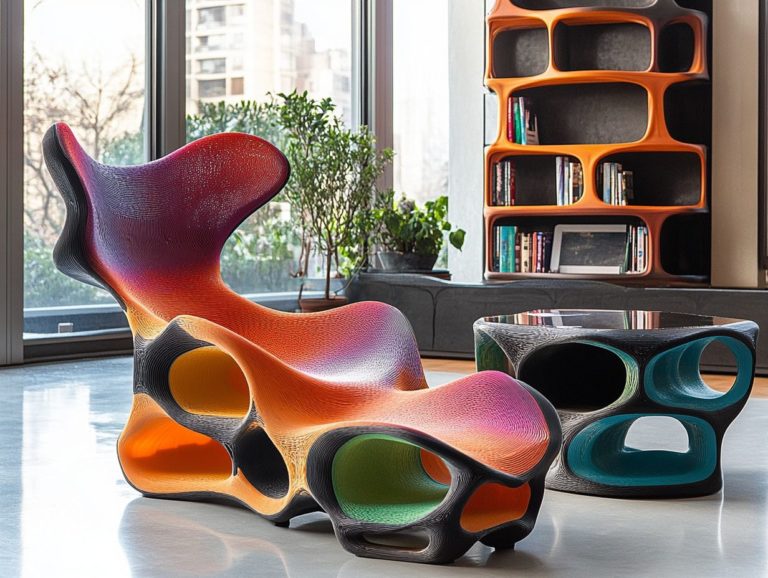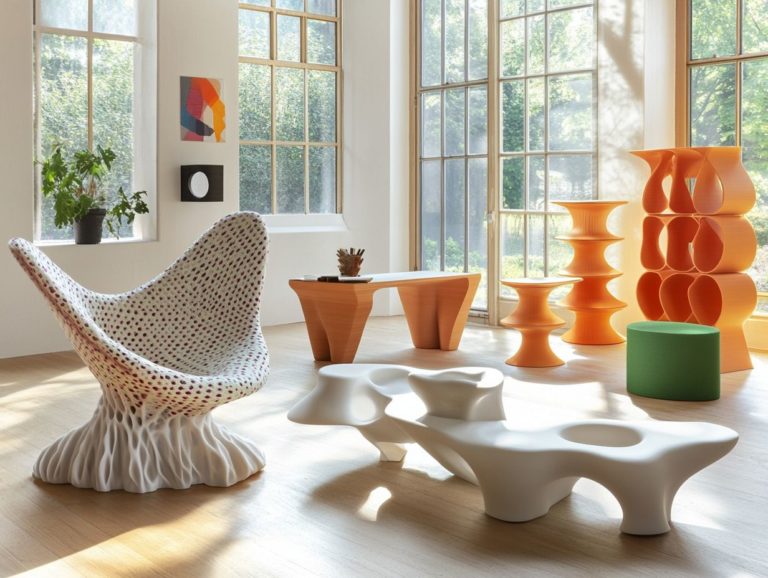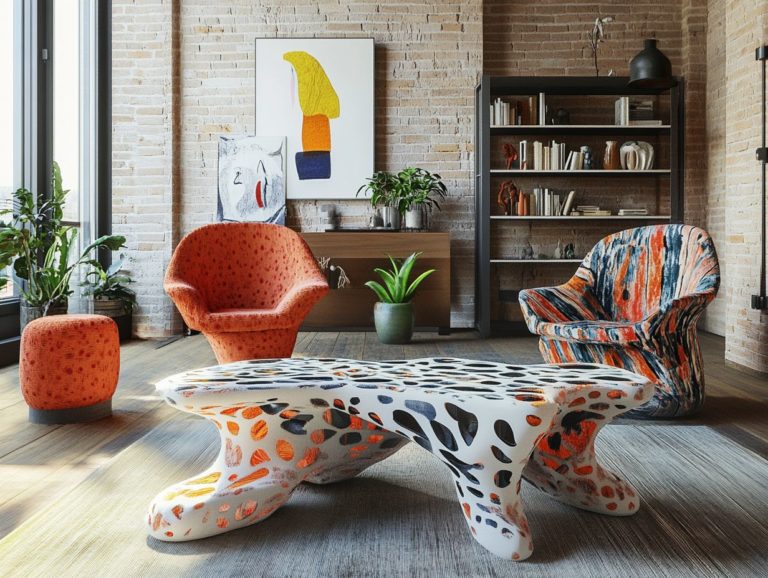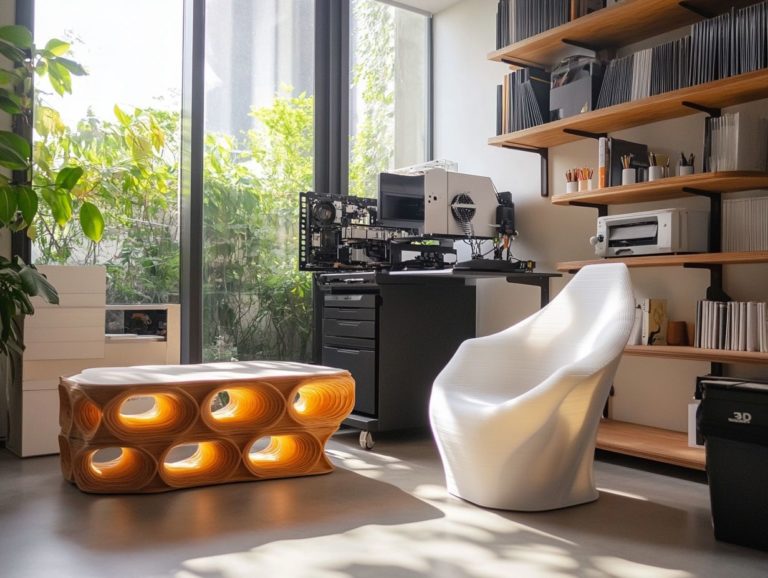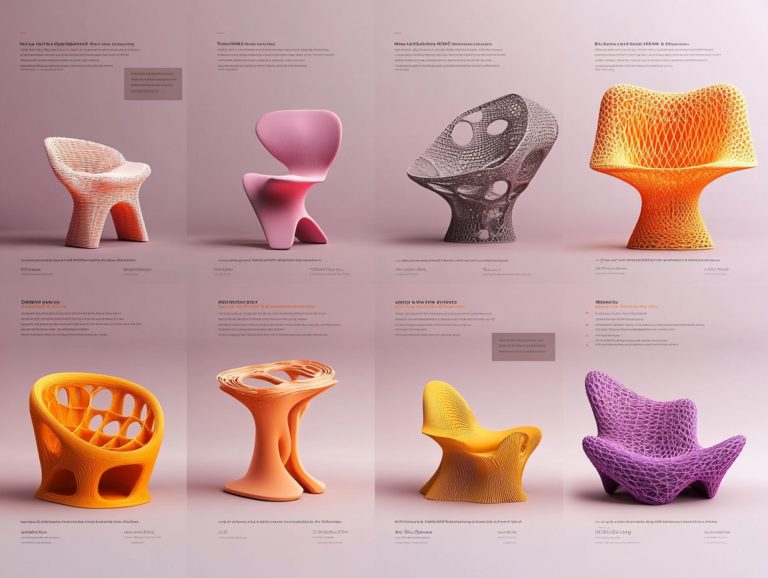5 Must-Have 3D-Printed Furniture Items for Your Home
In a world where innovation seamlessly intertwines with practicality, 3D-printed furniture is revolutionizing your approach to home decor.
Picture this: unique, customizable designs tailored to your style, budget, and environmental values. From lightweight, easy-to-assemble pieces to robust designs that optimize your space, this exploration introduces five essential 3D-printed furniture items poised to elevate your living area.
You ll also delve into how this advanced technology operates, the materials involved, its myriad benefits and limitations, and what the future could hold for your home.
Are you ready to transform your space now? Let s dive in!
Contents
- Key Takeaways:
- 1. Unique and Customizable Designs!
- 2. Affordable and Sustainable Options!
- 3. Lightweight and Easy to Assemble!
- 4. Durable and Long-Lasting
- 5. Multifunctional and Space-Saving
- How Does 3D Printing Work for Furniture?
- Frequently Asked Questions
- What are 5 must-have 3D-printed furniture items for my home?
- How can 3D-printed furniture enhance my home’s interior design?
- Are 3D-printed furniture items durable enough for everyday use?
- Can I customize the design of my 3D-printed furniture items?
- Curious about how 3D printing can revolutionize your furniture experience?
- Is it possible to recycle 3D-printed furniture items?
Key Takeaways:
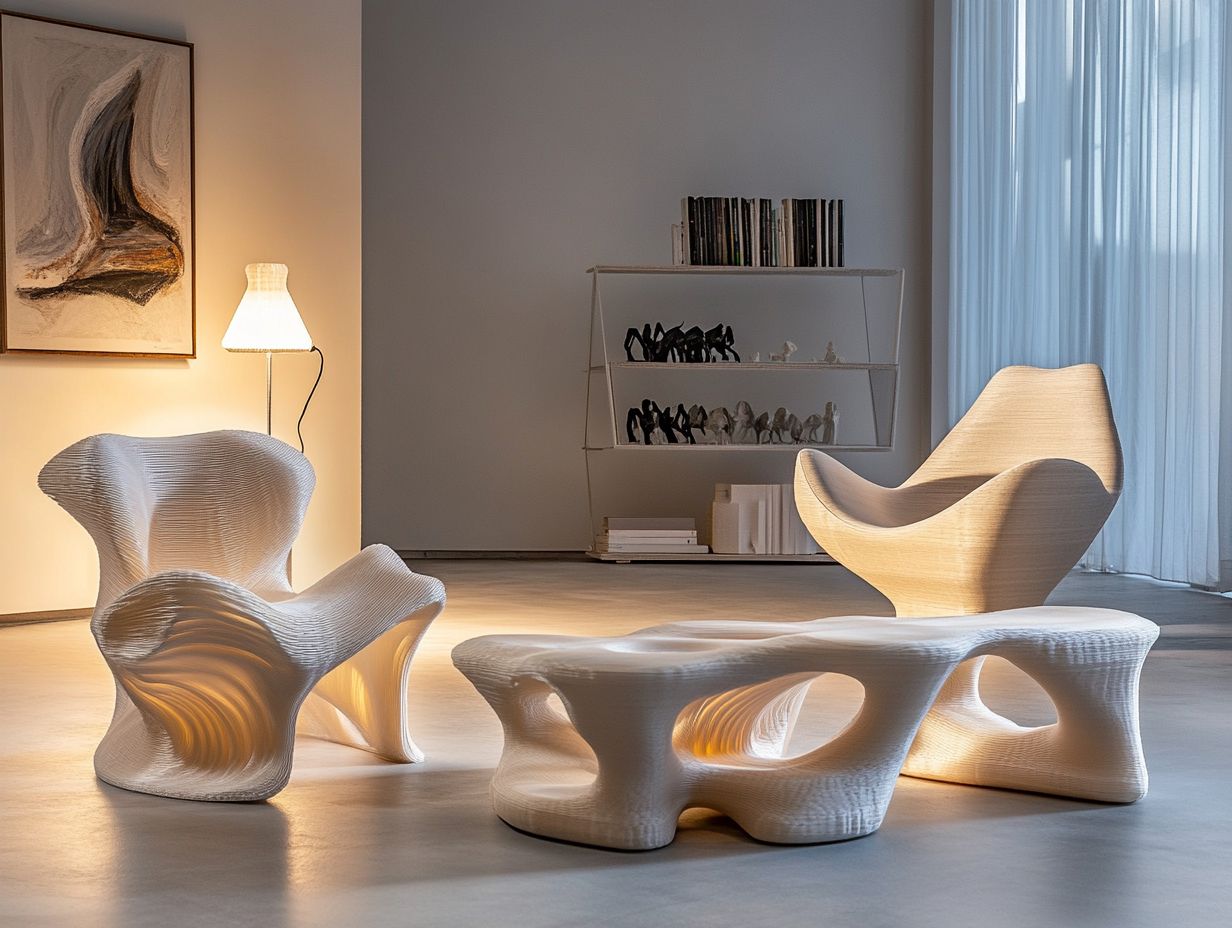
- Unique and customizable designs make 3D-printed furniture a standout addition to any home decor.
- Affordable and sustainable options allow for stylish and eco-friendly furniture choices.
- Lightweight and easy to assemble, 3D-printed furniture offers convenient and portable solutions for any space.
1. Unique and Customizable Designs!
The rise of 3D printing, a method that creates objects by layering materials, has transformed furniture design. It opens the door to unique and customizable pieces that reflect your individual tastes and needs. Think of renowned designers like Patrick Jouin and cutting-edge firms like Materialise MGX, who are leading the charge in this revolution.
With 3D printing at your fingertips, you can explore intricate structures that were once impossible to create. Take the Gaudi series, for example, with its organic shapes inspired by nature, allowing each piece to be tailored perfectly to your space. If you’re unsure about what to select, check out this guide on how to choose the right 3D-printed furniture for your home. The Root Chair is a stunning blend of form and function, merging contemporary aesthetics with practicality, ensuring that every chair mirrors your personality.
This level of personalization not only elevates your experience but also invites you to engage in the design process, sparking creativity and deepening your connection to your furniture.
2. Affordable and Sustainable Options!
As 3D printing becomes increasingly accessible, you find yourself at the forefront of a revolution in affordable and sustainable furniture options. This technology paves the way for innovative designs, including stunning 3D-printed tables for modern homes, along with cutting-edge gaming chairs and one-of-a-kind storage solutions crafted by visionary designers like John Briscella.
This advancement offers a genuine solution to reducing waste and material costs in the furniture industry. Traditional manufacturing often leaves behind a significant amount of leftover materials, while 3D printing optimizes resources by utilizing only the exact amount needed, cutting down on excess waste.
For example, a study from the University of Illinois revealed that 3D printing can reduce material waste by up to 90%. A case study of a startup specializing in 3D-printed furniture demonstrated that production costs were slashed by nearly 50% compared to conventional woodworking methods. This showcases immense potential for both affordability and sustainability in the long run, inviting you to embrace this transformative approach.
3. Lightweight and Easy to Assemble!
One of the standout benefits of 3D printed furniture is its lightweight nature. This attribute not only makes it a breeze to transport but also simplifies assembly, enhancing the allure of decorative items like vases and customized planter pots.
The materials used in this innovative design often feature durable, lightweight thermoplastics and eco-friendly materials that break down naturally. These choices significantly reduce weight without sacrificing strength, allowing for intricate designs and a sleek aesthetic that elevate the modern appeal of these items.
Assembly techniques are also remarkably streamlined; many pieces snap together or require minimal fasteners, making the process intuitive and user-friendly. For example, light fixtures crafted from 3D-printed components can typically be assembled in mere minutes, effortlessly transforming any space without the hassle of complex installation procedures. This provides you with a seamless and satisfying experience.
4. Durable and Long-Lasting
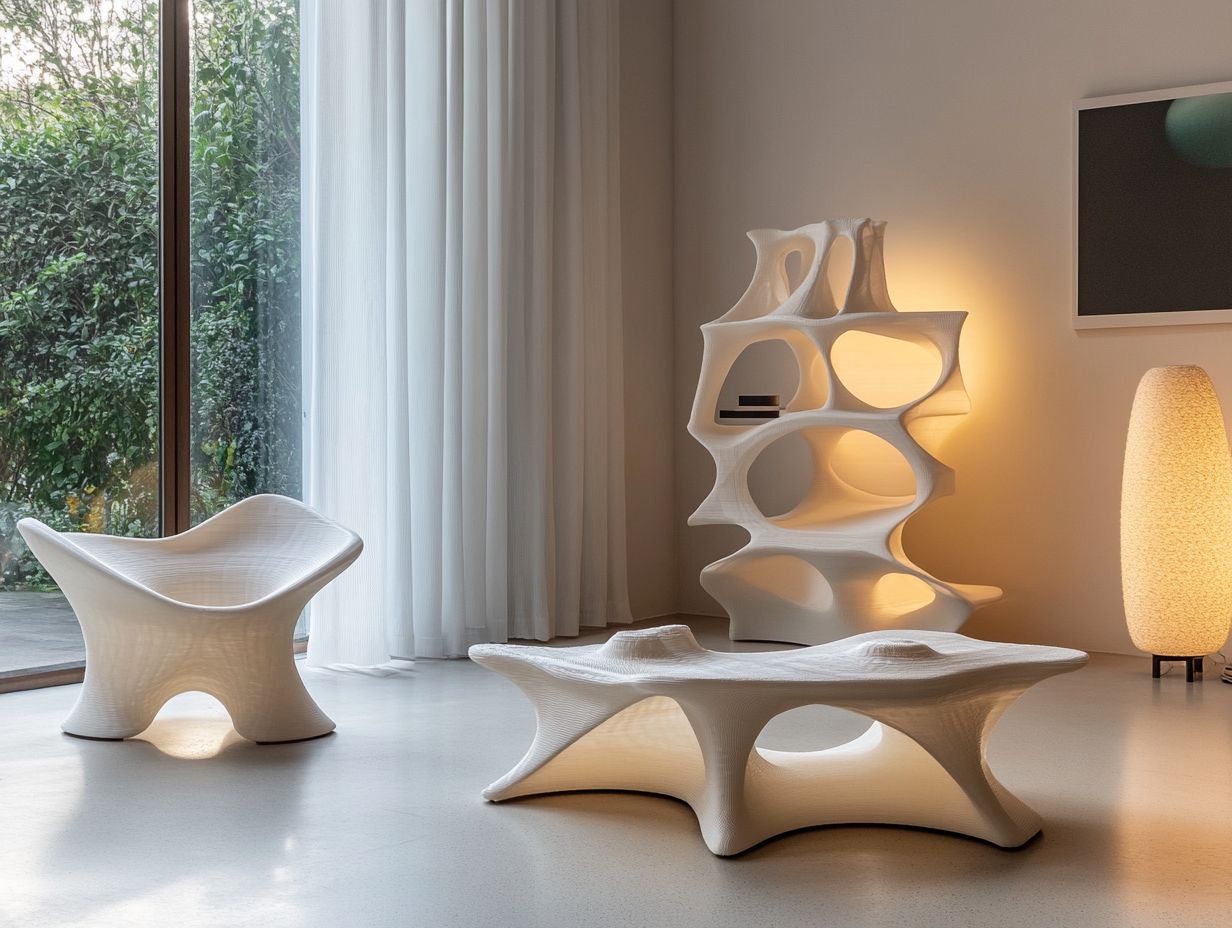
Through advanced 3D printing technology, you can explore the remarkable work of designers like Patrick Jouin. They create durable and long-lasting furniture that showcases innovative designs while standing the test of time.
Just think of those stunning 3D printed lamps and other unique pieces that are redefining the furniture landscape. This process uses high-quality materials like thermoplastics (a type of plastic that becomes soft when heated, allowing for easy shaping) and composites, significantly enhancing the structural integrity and lifespan of each item.
Unlike traditional wooden or upholstered furniture, which can easily succumb to wear and tear, 3D printed designs offer superior resistance to environmental stressors. The layered manufacturing technique allows for intricate designs that maintain stability without sacrificing aesthetics.
As a result, you re not just captivated by the modern style; you re also investing in substantial long-term value, all thanks to the enduring nature of these innovative creations.
5. Multifunctional and Space-Saving
The emergence of multifunctional and space-saving furniture, thanks to 3D printing, gives you the power to maximize your living spaces without compromising on style. This is evident in the top 10 innovative 3D-printed furniture pieces and designs that utilize cutting-edge 3D flocking simulation techniques.
Imagine the possibilities! These creative concepts can transform small areas into functional havens, accommodating everything from workspaces to guest beds. What makes these designs truly appealing is their remarkable flexibility, seamlessly adapting to your various needs throughout the day.
Picture a sleek coffee table that effortlessly converts into a dining surface or a compact bookshelf that unfolds into a workspace in mere seconds. This versatility not only elevates the aesthetic of modern homes but also caters to the increasing demand for practicality in urban living.
With advancements in 3D printing technology, these unique pieces can be custom-made, tailored specifically to your preferences and requirements.
How Does 3D Printing Work for Furniture?
3D printing, especially through the stereolithography process (a method that uses light to solidify liquid resin into precise shapes), gives you the power to explore a realm of intricate and innovative furniture design that was once the stuff of dreams. Designers and studios like Joris Laarman Studio and MGX are leading this transformation, reshaping the landscape of furniture as we know it.
This technology employs a digital template to construct objects layer by layer, utilizing materials such as thermoplastics or resin. It all begins with a 3D model, meticulously sliced into numerous cross-sectional layers.
Each layer is crafted with precision, whether through a UV laser curing resin or by depositing molten plastic, granting you unparalleled design freedom. As this technology advances, you ll encounter a fascinating mix of opportunities and challenges.
While the potential for customization is immense, considerations around sustainability, material sourcing, and production costs demand your attention. Looking ahead, the future of furniture design may well favor smaller, bespoke pieces tailored specifically to individual preferences, marking the dawn of a new era defined by personalization and innovation.
What Materials Are Used in 3D-Printed Furniture?
The materials you choose for 3D-printed furniture are essential in shaping its quality, sustainability, and overall design. They offer a wealth of options that meet both the aesthetic and functional demands of designer furniture.
Among the most popular choices are various plastics, such as PLA and ABS. These materials allow for vibrant colors and intricate designs while keeping the structure lightweight.
Conversely, metals like aluminum and stainless steel bring durability and strength to the table quite literally making them perfect for robust pieces such as tables or chairs designed for heavy use.
Emerging bio-materials are also making a mark, providing an eco-friendly alternative that champions sustainability, especially for items aimed at environmentally conscious consumers. Each material not only elevates the visual appeal but also plays a critical role in functionality, redefining conventional notions of what furniture can truly achieve.
What Are the Benefits of 3D-Printed Furniture?
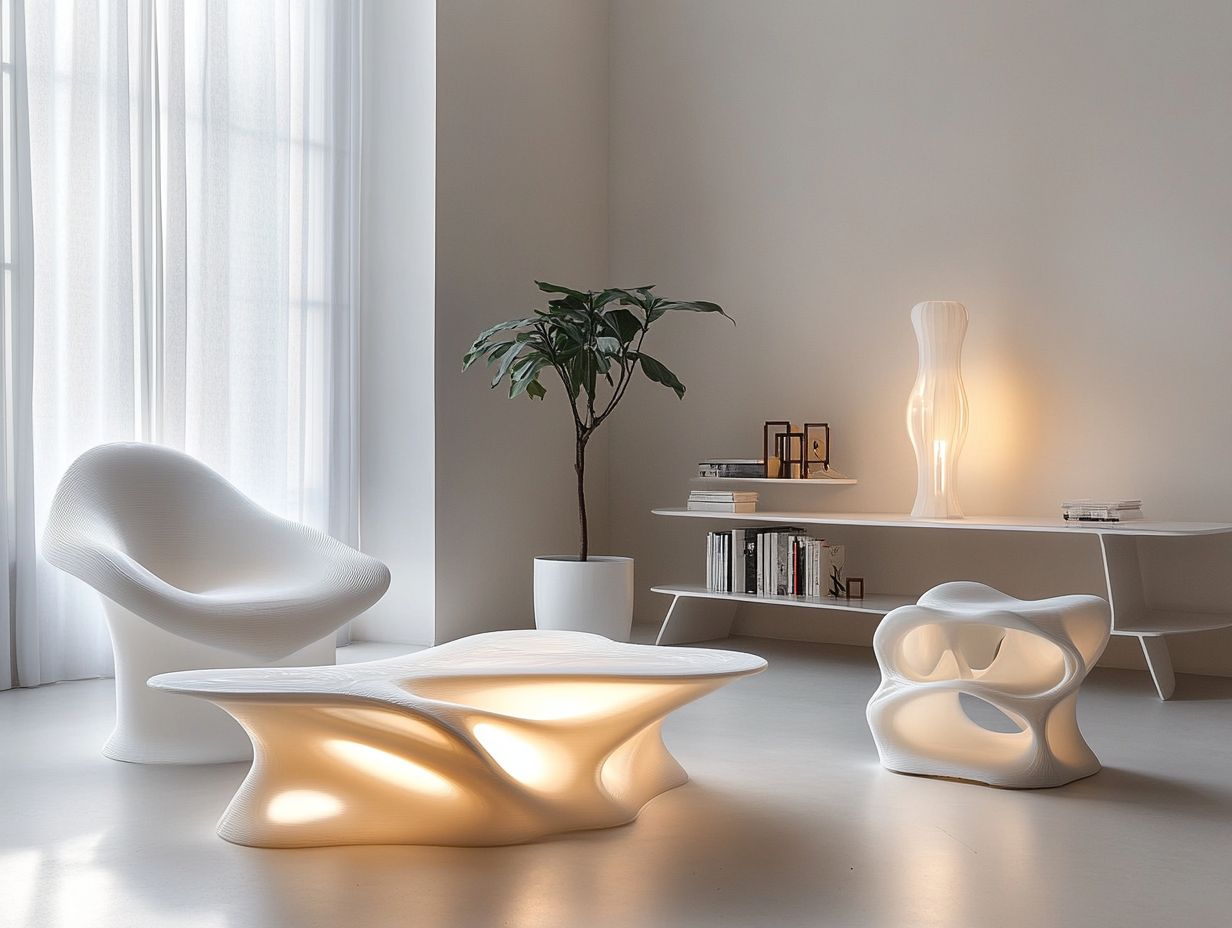
The benefits of 3D-printed furniture are exciting and truly remarkable, offering you the opportunity to create unique pieces tailored to your individual preferences.
The customizable designs that this cutting-edge manufacturing method allows simply can t be matched by traditional techniques.
This innovative approach significantly reduces waste; materials are utilized far more efficiently than in conventional processes. For instance, well-known designers like Maximilian K. harness 3D printing to produce furniture that not only minimizes excess material but also features intricate shapes that truly capture attention.
Since 3D-printed furniture is usually designed digitally, you can visualize options and make adjustments in real-time, enriching your personalized experience. To maximize your design process, consider these 5 tips for designing your own 3D-printed furniture. This method has the potential to lower production costs, allowing for affordability without compromising on quality, making chic, modern designs accessible to a wider audience.
What Are the Limitations of 3D-Printed Furniture?
While 3D printing presents a wealth of advantages in furniture design, it’s crucial for you to consider its limitations.
Durability, material options, and production speed present challenges that could impact your choices.
Durability is a primary concern; 3D-printed pieces may not hold up under heavy use or harsh conditions as well as those crafted from established materials like hardwood or metal.
The variety of materials suitable for 3D printing can also be quite restricted, often resulting in designs that lack the aesthetic appeal or structural integrity found in traditional furniture.
Though 3D printing might seem like a quick solution, producing items in bulk can actually be slower than conventional manufacturing processes. This difference underscores that while 3D printing offers highly customized designs, those of you who prioritize longevity and reliability might still find yourself gravitating toward the timeless quality of traditional craftsmanship.
How Can One Incorporate 3D-Printed Furniture into Their Home Decor?
Incorporating 3D-printed furniture into your home decor offers a splendid opportunity to showcase your individual style through unique pieces, such as stylish 3D-printed furniture for kids’ rooms, all while leveraging interactive video tools to visualize how these designs will fit into your space.
With tools that let you visualize furniture in your space using your phone or tablet, you can easily see a digital representation of how a specific piece complements your existing decor. This ensures your selections harmonize beautifully with the overall aesthetic of your home.
When arranging your 3D-printed items, it’s crucial to consider the scale, color, and material in relation to the room’s dimensions and style. In a minimalist setting, for instance, opting for sleek, simple designs can maintain an uncluttered vibe, while more intricate pieces can infuse character into a rustic or eclectic environment.
Keeping functionality at the forefront while arranging these unique pieces not only elevates visual appeal but also maximizes comfort and usability.
What Is the Future of 3D-Printed Furniture?
The future of 3D-printed furniture is exceptionally bright for you, as advancements in 3D printing technology are ushering in innovative and sustainable options that challenge conventional furniture design.
With new materials like bio-based plastics and recycled composites gaining popularity, the potential for eco-friendly furniture is expanding significantly. This shift not only offers you unique design aesthetics but also fosters a circular economy, effectively reducing waste.
As a result, designers are empowered to explore intricate geometries and customizable features that truly resonate with your individual preferences. As these technologies advance, you could find yourself enjoying an enriched purchasing experience, with the ability to tailor items to your specific needs. This ultimately cultivates a more engaging relationship between you and your furniture.
Such a transformative approach has the potential to redefine market standards and ignite even greater creativity in the field. Keep an eye on new designs and trends as you explore these innovations!
Frequently Asked Questions
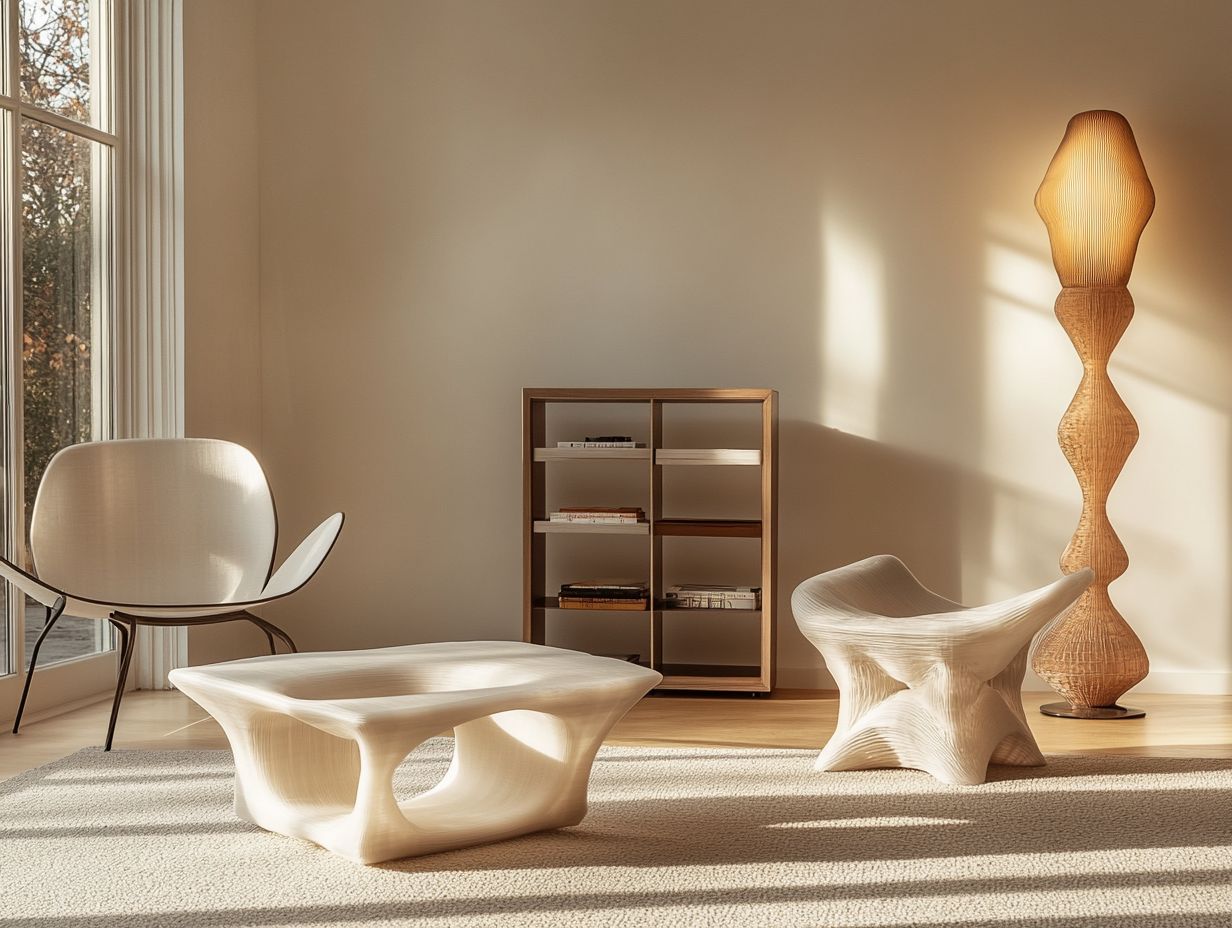
What are 5 must-have 3D-printed furniture items for my home?
The 5 stylish 3D-printed furniture solutions for your home are a 3D-printed chair, table, bookshelf, lamp, and vase. These items are functional and showcase the potential of 3D printing technology in creating unique home decor.
How can 3D-printed furniture enhance my home’s interior design?
Imagine how 3D-printed furniture can transform your home into a modern masterpiece! With 3D printing, you can design pieces that perfectly match your home’s aesthetic and style.
Are 3D-printed furniture items durable enough for everyday use?
Yes, 3D-printed furniture items are durable enough for daily use. New materials in 3D printing, like strong plastics often used in construction, ensure that these pieces can withstand wear and tear just like traditional furniture.
Can I customize the design of my 3D-printed furniture items?
Yes! One of the best advantages of 3D-printed furniture is its customization potential. You can choose from various designs or create your own, allowing for unique pieces tailored to your style.
Curious about how 3D printing can revolutionize your furniture experience?
The benefits of using 3D printing technology for furniture include cost-effectiveness, design flexibility, and reduced waste. You can produce furniture on demand, cutting down storage and inventory costs.
Is it possible to recycle 3D-printed furniture items?
Yes, you can recycle 3D-printed furniture items! Most printing materials, like plastic and metal, can be reused. Just remember to dispose of any failed prints properly to minimize waste and environmental impact.
Don’t miss out on the chance to customize your home with stunning 3D-printed designs!

